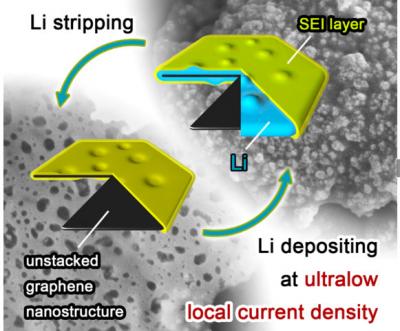Researchers at Tsinghua University, China have devised a graphene-based nanostructured lithium metal anode for lithium metal batteries, to inhibit dendrite growth and improve electrochemistry performance.

New lithium metal anode batteries, like Li-S and Li-air batteries, are highly sought after, as lithium metal provides an extremely high theoretical specific capacity, which is almost 10 times more energy than graphite. The problem is that the practical applications of lithium metals are significantly hindered by lithium dendrite growth in continuous cycles. This induces safety concerns since it may cause internal short circuits resulting in fire. Furthermore, the formation of lithium dendrites induces very low cycling efficiency. This is why inhibiting the dendrites growth, as was attempted by the researchers in this study, is highly expected.
The scientists used unstacked graphene with an ultrahigh specific surface area to build a nanostructured anode. Additionally, they have employed the dual-salt electrolyte to acquire more stable and more flexible solid electrolyte interphase, which can protect the lithium metal from further reactions with electrolyte. This graphene-based anode offered great improvement, including ultralow local current density on the surface of graphene anode (a ten-thousandth of that on routine Cu foil-based anodes) induced by the large specific surface area, which inhibited dendrite growth and brought uniform lithium deposition morphology; Also, high stable cycling capacity of 4.0 mAh mg-1 induced by the high pore volume (1.65 cm3 g-1) of unstacked graphene, over 10 times of the graphite anode in lithium-ion batteries (0.372 mAh mg-1); In addition, high electrical conductivity (435 S cm-1), leading to low interface impedance, stable charging/discharging performance, and high cycling efficiencies.
Future investigation is required to design preferable anode structures and to produce more protective solid electrolyte interphase layers. The researchers also call for additional study of the diffusion behavior of Li ions and electrons in the process of lithium depositing and stripping to advance the commercial applications of lithium metal anodes.



